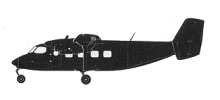Incident Overview

Description
The Antonov 28 was on a ‘wet lease’ hire to the Royal Air Force Sport Parachute Association (RAFSPA) for parachute operations from RAF Weston-on-the-Green, from the 27 August 1993 to 6 September 1993. On Saturday 28 August 1993, the aircraft had completed twelve flights, each of approximately 15 minutes duration, carrying up to 17 parachutists involved in ‘free fall’ parachuting over the airfield. On the thirteenth flight the aircraft departed from runway 36 with 17 parachutists and 2 crew on board. As the aircraft reached a height of approximately 500 feet above ground level (agl) both engines simultaneously suffered total power loss. With no time to resolve the situation, the crew carried out a forced landing in a large field of cut crop adjacent to the airfield. The aircraft landed heavily and was damaged beyond repair, however the passengers and crew vacated the aircraft without injury. CAUSAL FACTORS: i) A latent defect in the electrical system caused a simultaneous total power loss as the flaps were retracted at 500 feet agl on climb out, with automatic operation of both asymmetric spoiler systems. ii) The latent defect had been caused by progressive loosening of a single earthing screw, which provided a common earth point for the flap electric signalling and propeller auto feathering systems. This induced a high resistance to earth at this point and caused feathering of both propellers when flap retraction was selected, in addition to automatic closure of both engine fuel shut-off valves (within the fuel control units) and extension of both outboard spoilers. iii) At manufacture in Poland a single earthing point had been installed which was not in accordance with the design requirements for this aircraft type as issued by the Antonov Design Bureau, which had required dual combined earthing terminals for the flap signalling and propeller auto feathering systems. iv) The Antonov Design Bureau had never cleared this type of aircraft for flight with the aft clam-shell doors removed, or for parachute training. v) This aircraft had been incorrectly granted an Aerial Work Permit for parachuting operations in the UK by the Department of Transport, assisted by the CAA, as a result of implicit reliance upon submitted documentation which was subsequently proven invalid.
Primary Cause
i) A latent defect in the electrical system caused a simultaneous total power loss as the flaps were retracted at 500 feet agl on climb out, with automatic operation of both asymmetric spoiler systems.i) A latent defect in the electrical system caused a simultaneous total power loss as the flaps were retracted at 500 feet agl on climb out, with automatic operation of both asymmetric spoiler systems.Share on:




